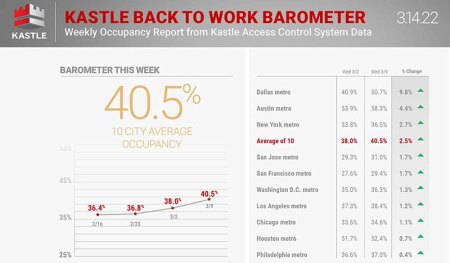This month marks two full years since most U.S office workers began full-time remote work. An increasing number of people, ranging from the federal government to small businesses, are now saying that it is time for employees to return to the office.
President Joe Biden called on Americans earlier this month in his “State of the Union” address to get back to work and “fill our great downtowns again.” The federal government is now driving the return to normal. Despite this, Gallup research shows that when it comes to returning to the office, the majority of employees nationwide wish to do so in moderation. Meanwhile, COVID-19 cases are rising again in several countries in Europe and Asia.
Around 45 percent of office workers would prefer to work hybrid schedules compared with 23 percent who would like to return to the workplace full-time, according to Nicholas Bloom, a professor of economics at Stanford University. Bloom is also a cofounder of the “Working from Home Research Project” and says that roughly 32 percent of employees would opt to continue working remotely.
Despite this, some companies, such as Goldman Sachs, have announced that they want all company employees back in the office five days a week. Data from Kastle Systems for the week of March 14 showed occupancy at 40.5 percent in the 10 largest U.S. markets with Texas cities leading the way.
“One Fortune 100 tech company is betting on employees connecting on ideas and collaborating over breakfast, lunch, and afternoon snacks, which can only happen with teams being local and onsite together,” says Roger McCarron, president and CEO of Project Management Advisors (PMA). “While it’s not a new offering, it seems to be one of the strongest drivers for employees returning to the office, in addition to the personal relationships. A high percentage of people genuinely miss one another.” McCarron had previously spoke to Urban Land about return-to-office negotiations.
Google is among the big tech companies recently announcing it also wants employees to return to the office. However, both Google and Apple will reportedly allow some employees to work hybrid schedules beginning in April.
Company leaders at Amazon, Pinterest, Intel, and PayPal concede they are concerned about possibly losing talent if they demand employees return to the office full-time. Executives say they realize many employees would prefer a hybrid approach instead, according to CNBC. Meanwhile, there are some offices nationwide that never closed their doors in the first place.
Open for Business
“As an organization, EQ never left,” says Charlie Hobey, managing director, product, and operations at Chicago-based EQ Office. “Throughout the pandemic, our doors have remained open to our clients. We don’t like to call this a ‘return to office,’ but rather a ‘return to experience.’”
Hobey said his company’s December tenant survey showed that more than two-thirds of those who responded plan to return to office sometime in the first quarter of 2022, but it varies according to the industry and location “with energy, healthcare and life sciences, legal services, and real estate seeing a stronger pull to a Q1 return.” Miami and the West Coast properties also have “a stronger appetite” for that timeframe, he said.
Others have found the pandemic has taught lessons that employers and employees will benefit from in the future. For some, this includes realizing what has been lost by working remotely.
“I think what this pandemic has demonstrated to a lot of people is that we can be productive in a remote environment, but we’re nowhere near as efficient, and it’s nowhere near as efficient from a communication standpoint,” says Clare De Briere, executive vice president at Skanska USA Commercial Development. “It’s nowhere near as productive in the creative realm. We don’t get those sparks of creativity that you get when you’re in person and you’re building with each other and you’re able to have that one on one or three on one conversation.”
Another lesson learned is that many companies have become better at taking advantage of using technology to be able to include an array of people from different locations, according to De Briere. This includes for webinars, remote meetings, and a “visioning process” her company participated in during the lockdowns.
While connecting with employees in the company’s Houston and Seattle offices virtually, she said the experience was “seamless.” De Briere says many companies will be able to continue to benefit from technology in this way.
“I think from a business travel standpoint, we’re probably going to be able to have more of those sorts of presentation style meetings virtually and save some of our carbon footprint … not have to travel quite as much,” De Briere says.
This could prove to be beneficial for other companies as well. However, De Briere is convinced there are still some important aspects of work that technology simply cannot replace.
“There was a lot of culture that was lost,” says De Briere, whose Los Angeles office returned to work full time in January. “It’s really, really hard to drive a corporate culture when you’re not able to be with each other and work with each other every day. I think there’s also that aspect of working together where our younger team members can learn so much just by listening to phone calls or hearing conversations or being pulled into meetings.”
McCarron echoes the sentiment. He says opportunities to mentor and educate fellow employees occur “more organically” when people are in the same workspace.
“The office bolsters creativity through conversation,” says McCarron. “The threshold for asking a simple question is much lower in person than it is with electronic communication. Those questions are met with immediate answers, which is more gratifying and meaningful than chasing a string of emails.”
There are also added challenges. Scott Nelson, global CEO of occupier services at Colliers International, says some companies have found it hard to preserve the cohesiveness of their organizations.
As a result, remote work has caused some employers to feel “more disconnected from their people,” Nelson says. Working remotely has also made it more difficult to maintain the corporate culture that has helped companies attract and retain employees. Nelson adds it can be challenging to “give people the opportunity to advance their career and build relationships and those kinds of things when people aren’t sitting literally with each other in the same room on a regular basis.”
Still, there are employees who will have a difficult time letting go of what they’ve gained during the pandemic by being able to work offsite full time. Chris Congdon, Steelcase, director of global research communications, acknowledges this fact and says, as a result, many companies will have their work cut out for them.
“Over the past two years, workers had greater choice, control and privacy while at home – benefits they now aren’t willing to give up,” says Congdon. “However, they also felt isolated and disconnected from their organization. The challenge for organizations today is to rebuild company culture and reignite social connections. Most organizations will choose a hybrid model of work but maintaining culture and rebuilding trust among teams will be a challenge leaders have to face.”
As employees return to the office, experts say many employers will have a new job assignment themselves: earning the commute time of their employees. An emphasis on new amenities for employees will likely be implemented as a result.
“Onsite is the new offsite,” says Emily Williams, vice president of workplace experience at Raise Commercial Real Estate. “Several of our clients are deepening their investments in spaces aimed at improving employee experience and cultural programs, including full-service coffee bars, onsite wellness activation areas, and large event spaces for on-site events. Executive Business Centers, aimed at supporting cross-functional team events and client-facing programs, are also a focus of companies seeking to deepen investments.”
Many employers will have to up their game, McCarron agrees. It boils down to showing employees how beneficial being in the workplace is.
“The challenge now is to extract the most value from the office, to create spaces that capitalize on the value of team members being together in person, and to ensure people have the right kinds of space to complete their work without overcommitting to private offices or open desks or other kinds of workspaces,” says McCarron.
Flexibility Is Key
The majority of tenants are likely still planning to institute hybrid schedules for their employees, according to some experts. Hobey says 85 percent of tenants he has spoken with are aiming for “a mix of in-office and remote” for a variety of reasons.
“Among the main reasons for this is the race for talent,” says Hobey. “And we’re seeing that talent wants it both ways – to work from home when they want and to work at the office when they want.”
The key to making these new spaces successful will be gaining insight from employees, according to Williams. This will be critical going forward.
“Successful return to office engagement and program adoption are with companies that have spent time initially engaging with employees to gather their feedback,” says Williams. “Digging into what they crave in their workplaces that they’re not receiving in remote environments will turn office-access planning into an “and” not an “or” conversation.”
When employees return, many office experts say the new expectations in place will include more than a reimagining of spaces. There will also now be more of an emphasis on health and wellness. While De Briere says this shift was already occurring before the pandemic, she believes it has now been accelerated as does Williams.
“Ensuring environmental health and safety in the workplace has been a top investment priority for businesses looking to encourage employees to return to the workplace,” says Williams. “We’re seeing this with advancing technology, equipment, and programs that not only improve health and safety measures, but also give employees more visibility into and control over their workplace environments.”
Williams adds there have also been “notable improvements and investments” made to air filtration equipment as well as to heating, ventilation, and air conditioning and operating systems. Congdon adds some clients are even rearranging the furniture to “intentionally help mitigate the spread of airborne particles” in the workplace.
“The goal is to create a workplace that’s comfortable for all, but also ready to change as conditions demand,” says Congdon.
Nelson agrees change is in the air. He says tenants are being encouraged to approach things differently.
“What we’re thinking about the most and advising clients the most on is how they curate experiences for their people in their spaces, so having a hospitality mindset,” says Nelson.
This can even be applied to making meetings more of a collaborative experience which allows employees to forge relationships. Some point out that there could also be more of an emphasis on indoor/outdoor spaces. This is especially true since many employers are aware that employees have grown accustomed to spending more time outside, in their gardens or simply walking around their neighborhoods, during the day while working remotely.
Employers may choose to incorporate technology around their increasingly collaborative spaces. It is clear health concerns will remain a top-of-mind priority for employees as well.
“We’ve had two years to learn how to live with the uncertainty of COVID-19 and have more defenses in place to keep people safe and healthy,” says McCarron. “Even in our own offices, there’s a visible difference in the comfort of employees now than there was a year ago. How those defenses are deployed happens at the local and regional level, and return-to-office has largely followed suit. As an example, many Chicago offices returned their employees March 1 with optional mask policies, but Los Angeles-based offices are not returning until the end of the month, with masks still required.”
Nelson says some companies will also maintain their office space or even require more. Still, commercial real estate leaders agree there is no “crystal ball” regarding what the future will hold, but there are some certainties.
“Today’s workforce wants to feel trusted and empowered to make the best choices about how, when, and where they get their best work done, whether that’s remote or in-person,” says Williams. “We believe most people want to have the tools and infrastructure in place to do both.”
From ULI Hong Kong: Industry Pulse Check: COVID-19 Control Measures in the Workplace








